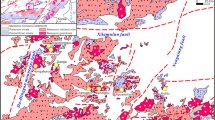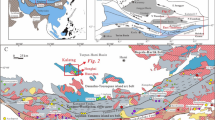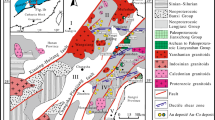Abstract
The Shaxi porphyry Cu–Au deposit is located in the northern part of the Luzong Basin on the outer edge of the southern Middle-Lower Yangtze River metallogenic belt, China. It is typical of the porphyry Cu–Au deposits in the metallogenic belt, with more than 1 Mt Cu at 0.55 wt% and 45 tons Au at 0.47 g/t. Hydrothermal alteration consists of a core of potassic alteration overprinted by a phyllic alteration zone. Propylitic alteration occurs peripheral to the potassic zone, but can also be recognized in the core of the deposit, where vein density is low. The main mineralization occurs as sulfide veinlets in the potassic zone where it is superposed by phyllic alteration. The paragenetic sequence show that chalcopyrite began to precipitate late in stage 1, associated with potassic alteration, forming quartz-sulfide veins with potassium feldspar halos, and reached a peak in stage 3, forming chalcopyrite-pyrite ± quartz ± anhydrite ± chlorite ± illite veins that accompanied phyllic alteration. Sulfur, hydrogen-oxygen and strontium isotopes, fluid inclusions, and pyrite trace element data indicate that the stage 1 assemblage associated with potassic alteration were deposited from a magmatic brine. With the change from lithostatic to hydrostatic pressure late in stage 1, the brine generated stage 1 g quartz-pyrite-chalcopyrite ± anhydrite ± bornite ± molybdenite ± potassium feldspar veins with minor copper and gold. Mixing with minor external fluids (meteoric water or gypsum-saturated groundwater) in stage 2 triggered the peripheral propylitic alteration. As the proportion of external fluid increased with the onset of hydrostatic conditions, it changed the redox state and composition of the hydrothermal system, resulting in extensive stage 3 Cu and Au precipitation with phyllic alteration. Argillic alteration associated with stage 4 veins was generated by external fluids mixed with minor hydrothermal fluid, at shallow depths.












Similar content being viewed by others
References
Audétat A, and Günther D (1999) Mobility and H2O loss from fluid inclusions in natural quartz crystals: Contrib Mineral Petr 137: 1-14
Becker SP, Fall A, Bodnar RJ (2008) Synthetic fluid inclusions. XVII. PVTX properties of high salinity H O-NaCl solutions (>30 wt% NaCl): application to fluid inclusions that homogenize by halite disappearance from porphyry copper and other hydrothermal ore deposits. Econ Geol 103:539–554
Bodnar RJ (1995) Fluid inclusion evidence for a magmatic source for metals in porphyry copper deposits. Mineralogical Association of Canada Short Course Series 23:139–152
Bralia A, Sabatini G, Troja F (1979) A revaluation of the co/Ni ratio in pyrite as geochemical tool in ore genesis problems. Mineral Deposita 14:353–374
Brill B (1989) Trace elements contents and partitioning of elements in ore minerals from the CSA Cu-Pb-Zn deposit, Australia. Can Mineral 27:263–274
Burnham CW (1979) Magmas and hydrothermal fluids. In: Barnes HL (ed) Geochemistry of hydrothermal ore deposits, 2nd edn. John Wiley & Sons, New York, pp 71–136
Burnham CW, and Ohmoto H (1980) Late-stage processes of felsic magmatism, in: S. Ishihara, S. Takenouchi (Eds.), Granitic Magmatism and Related Mineralization, Society of Resource Geologists of Japan 8, Tokyo: 1–11
Chang YF, Liu XP, Wu CY (1991) The copper-iron belt of the lower and middle reaches of the Changjiang River: Beijing. Geological Publishing House:1–379 (in Chinese with English abstract)
Chang ZS, Shu QH, Meinert LD (2019) Skarn deposits of China. Soc Econ Geol Spec Pub 22:189–234
Chen JS, Zhao R, Huo WG, Yao YY, Pan SL, Shao MR, Hai CZ (1981) Sulfur isotopes of some marine gypsum. Sci Geol Sin 3:273–278 (in Chinese with English abstract)
Chu XL, Chen JS, Wang SX (1984) Several diagrams of sulfur isotope evolution in equilibrium with hydrothermal system. Sci Geol Sin 2:186–200 (in Chinese with English abstract)
Chu XL, Chen JS, Wang SX (1986) Study on fractionation mechanism of sulfur isotope and physicochemical conditions of alteration and ore formation in Luohe iron deposit, Anhui. Sci Geol Sin 3:276–289 (in Chinese with English abstract)
Clayton RN, Mayeda TL (1963) The use of bromine pentafluoride in the extraction of oxygen from oxides and silicates for isotopic analysis. Geochim Cosmochim Acta 27:43–52
Cook NJ (1996) Mineralogy of the sulphide deposits at Sulitjelma, northern Norway. Ore Geol Rev 11:303–338
Danyushevsky L, Robinson P, Gilbert S, Norman M, Large R, McGoldrick P, Shelley M (2011) Routine quantitative multielement analysis of sulphide minerals by laser ablation ICP-MS: standard development and consideration of matrix effects. Geoch Explor Environ Anal 11:51–60
Deditius AP, Utsunomiya S, Reich M, Kesler SE, Ewing RC, Hough R, Walshe J (2011) Trace metal nanoparticles in pyrite. Ore Geol Rev 42:32–46
Deditius AP, Reich M, Kesler SE, Utsunomiya S, Chryssoulis SL, Walshe J, Ewing RC (2014) The coupled geochemistry of Au and As in pyrite from hydrothermal ore deposits. Geochim Cosmochim Acta 140:644–670
Deng JH, Yang XY, Li S, Gu HL, Mastoi AS, Sun WD (2016) Partial melting of subducted paleo-Pacific plate during the early cretaceous: constraint from adakitic rocks in the Shaxi porphyry Cu–Au deposit, Lower Yangtze River Belt. Lithos 262:651–667
Driesner T, Heinrich CA (2007) The system H2O-NaCl. Part I: correlation formulae for phase relations in temperature-pressure-composition space from 0 to 1000°C, 0 to 5000 bar, and 0 to 1 XNaCl. Geochim Cosmochim Acta 71:4880–4901
Eremin N (1983) Differentiation of volcanogenic sulfide deposits. Moscow state University Press, Moscow
Fontboté L, Kouzmanov K, Chiaradia M, Pokrovski GS (2017) Sulfide minerals in hydrothermal deposits. Elements 13:97–103
Fu B, Ren QJ, Hu WX (1996) Evolution and distribution of hydrothermal fluids in the Shaxi porphyry copper deposit, Anhui province. Mineral Deposits 15:23–33 (in Chinese with English abstract)
Fu B, Ren QJ, Xing FM, Xu ZW, Hu WX (1997) 40Ar-39Ar dating of copper (gold) -bearing porphyry in Shaxi, Anhui Province and its geological significance. Geological Rev 43:310–316 (in Chinese with English abstract)
Goldstein RH, Reynolds TJ (1994) Systematics of fluid inclusions in diagenetic minerals. Society for Sedimentary Geology. SEPM Short Course 31
Gregory MJ, Lang JR, Gilbert S, Hoal KO (2013) Geometallurgy of the pebble porphyry Cu-Au-Mo deposit, Alaska: implications for gold distribution and paragenesis. Econ Geol 108:463–482
Guillong M, Hametner K, Reusser E, Wilson SA, Günther D (2005) Preliminary characterisation of new glass reference materials (GSA1G, GSC1G, GSD1G, and GSE1G) by laser ablation-inductively coupled plasma-mass spectrometry using 193 nm, 213 nm, and 266 nm wavelengths. Geostand Geoanal Res 29:315–331
Gustafson LB, Hunt JP (1975) The porphyry copper deposit at El Salvador, Chile. Econ Geol 70(5):857–912
Hedenquist JW, Arribas AJ, Reynolds TJ (1998) Evolution of an intrusion-centered hydrothermal system: far Southeast-Lepanto porphyry and epithermal Cu-Au deposits. Philippines Econ Geol 93:373–404
Heinrich CA (2005) The physical and chemical evolution of low-salinity magmatic fluids at the porphyry to epithermal transition: a thermodynamic study. Mineral Deposita 39:864–889
Heinrich CA (2007) Fluid-fluid interactions in magmatic-hydrothermal ore formation. Rev Mineral Geochem 65:363–387
Henley RW, McNabb A (1978) Magmatic vapor plumes and groundwater interaction in porphyry copper emplacement. Econ Geol 73(1):1–20
Hou ZQ, Yang ZM (2009) Porphyry deposits in continental settings of China: geological characteristics, magmatic-hydrothermal system, and metallogenic model. Acta Geol Sin 83:1779–1817 (in Chinese with English abstract)
Huang SJ, Wu SJ, Sun ZL, Pei CR, Hu ZW (2005) Seawater strontium isotopes and paleo-oceanic events over the past 260 Ma. Earth Sci Frontiers 12:133–141 (in Chinese with English abstract)
Kouzmanov K, Pokrovski GS (2012) Hydrothermal controls on metal distribution in porphyry Cu (-Mo-Au) systems. Soc Econ Geol Spec Publ 16:573–618
Landtwing MR, Pettke T, Halter WE, Heinrich CA, Redmond PB, Einaudi MT, Kunze K (2005) Copper deposition during quartz dissolution by cooling magmatic-hydrothermal fluids: the Bingham porphyry. Earth Planet Sci Lett 235:229–243
Landtwing MR, Furrer C, Redmond PB, Pettke T, Guillong M, Heinrich CA (2010) The Bingham canyon porphyry Cu-Mo-Au deposit. III. Zoned copper-gold ore deposition by magmatic vapor expansion. Econ Geol 105:91–118
Large RR, Danyushevsky L, Hollit C, Maslennikov V, Meffre S, Gilbert S, Bull S, Scott R, Emsbo P, Thomas H, Singh B, Foster J (2009) Gold and trace element zonation in pyrite using a laser imaging technique: implications for the timing of gold in orogenic and Carlin-style sediment-hosted deposits. Econ Geol 104:635–668
Large RR, Halpin JA, Danyushevsky LV, Maslennikov VV, Bull SW, Long JA, Gregory DD, Lounejeva E, Lyons TW, Sack PJ, McGoldrick PJ, Calver CR (2014) Trace element content of sedimentary pyrite as a new proxy for deep-time ocean-atmosphere evolution. Earth Planet Sci Lett 389:209–220
Lecumberri-Sanchez P, Steele-MacInnis M, Bodnar RJ (2012) A numerical model to estimate trapping conditions of fluid inclusions that homogenize by halite disappearance. Geochim Cosmochim Acta 92:14–22
Lecumberri-Sanchez P, Steele-MacInnis M, Weis P, Driesner T, Bodnar RJ (2015) Salt precipitation in magmatic-hydrothermal systems associated with upper crustal plutons. Geology 43:1063–1066
Liu YQ, Liu ZL, Yang CX (1984) Stable isotope studies of the Dongguashan copper deposit in Tongling prefecture, Anhui Province. In: Bulletin of the Institute of Mineral Deposits, Chinese Academy of Geoligical Sciences, No. 1. Beijing: Geological Publishing House: 70–101 (in Chinese)
Loftus-Hills G, Solomon M (1967) Cobalt, nickel and selenium in sulphides as indicators of ore genesis. Mineral Deposita 2:228–242
Lowell JD, Guilbert JM (1970) Lateral and vertical alteration–mineralization zoning in porphyry ore deposits. Econ Geol 65(4):373–408
Lu QT, Hou ZQ, Yang ZS, Shi DN (2004) Underplating process and dynamics evolution mode in the Middle and Lower Reaches of Yangtze River: constrain of physical geography information. Sci China Ser D 34:783–794 (in Chinese)
Mao JW, Xie GQ, Duan C, Pirajno F, Ishiyama D, Chen YC (2011) A tectono-genetic model for porphyry-skarn-stratabound Cu-Au-Mo-Fe and magnetite-apatite deposits along the Middle-Lower Yangtze River Valley, Eastern China. Ore Geol Rev 43:294–314
Maslennikov VV, Maslennikova SP, Large RR, Danyushevskiy LV (2009) Study of trace element zonation in vent chimneys from the Silurian Yaman-Kasy volcanic-hosted massive sulfide deposit (Southern Urals, Russia) using laser ablation-inductively coupled plasma mass spectrometry (LA-ICP-MS). Econ Geol 104:1111–1141
Meinert LD, Hefton KK, Mayes D, Tasiran I (1997) Geology, zonation, and fluid evolution of the Big Gossan Cu-Au skarn deposit, Ertzberg district, Irian Jaya. Econ Geol 92:509–534
Meyer C, Hemley JJ (1967) Wall rock alteration. In: Barnes HL (ed) Geochemistry of hydrothermal ore deposits. Holt, Rinehart and Winston, New York, p 166–235
Ningwu Project Group (1978) The porphyrite iron deposit of Ningwu. Geological Publishing House, Beijing, pp 1–320 (in Chinese)
Ohmoto H, Rye RO (1979) Isotopes of sulfur and carbon. In: Geochemistry of hydrothermal ore deposits, 2nd edn. Holt Rinehart and Winston, New York, pp 509–567
Peng NJ, Jiang SY, Xiong SF, Pi DH (2018) Fluid evolution and ore genesis of the Dalingshang deposit, Dahutang W-Cu ore field, northern Jiangxi Province, South China. Miner Deposita 53:1079–1094
Potter RW, Clynne MA, Brown DL (1978) Freezing point depressions of aqueous sodium chloride solutions. Econ Geol 73:284–285
Qi L, Grégoire DC (2000) Determination of trace elements in twenty-six chinese geochemistry reference materials by inductively coupled plasma-mass spectrometry. Geostandard Newslett 24:51–63
Qiu JS, Ren QJ (1991) Spatial distribution pattern of ore-bearing fissures of the Shaxi porphyry copper (-gold) deposit and its metallogeny, Anhui. J Guilin Coll Geol 11:369–377 (in Chinese with English abstract)
Reich M, Kesler SE, Utsunomiya S, Palenik CS, Chryssoulis SL, Ewing RC (2005) Solubility of gold in arsenian pyrite. Geochim Cosmochim Acta 69:2781–2796
Ren QJ, Qiu JS, Xu ZW, Zhang CZ, Fang CQ, Yang RY (1991) Formation conditions of the mineralized stock in the Shaxi porphyry copper (gold) deposit, Anhui Province. Mineral Deposits 10:232–242 (in Chinese with English abstract)
Reynolds TJ, Beane RE (1985) Evolution of hydrothermal fluid characteristics at the Santa-Rita, New-Mexico, porphyry copper-deposit. Econ Geol 80(5):1328–1347
Roedder E (1971) Fluid inclusion studies on the porphyry-type ore deposits at Bingham, Utah, Butte, Montana, and Climax, Colorado. Econ Geol 66:98–118
Roedder E (1984) Fluid Inclusions: Reviews in Mineralogy:12 (646 p)
Roedder E, Bodnar RJ (1980) Geologic pressure determinations from fluid inclusion studies. Annu Rev Earth Planet Sci 8:263–301
Roedder E, Ribbe PH (1984) Fluid inclusions. Rev Mineral 12:644–645
Rusk BG, Reed M, Dilles JH (2008) Fluid inclusion evidence for magmatic-hydrothermal fluid evolution in the porphyry copper molybdenum deposit at Butte, Montana. Econ Geol 103:307–332
Shinohara H, Hedenquist JW (1997) Constraints on magma degassing beneath the Far Southeast porphyry Cu-Au deposit, Philippines. J Petrol 38:1741–1752
Shu Q, Lai Y, Sun Y, Wang C, Meng S (2013) Ore genesis and hydrothermal evolution of the Baiyinnuo’er zinc-lead skarn deposit, Northeast China: evidence from isotopes (S, Pb) and fluid inclusions. Econ Geol 108:835–860
Sillitoe RH (2010) Porphyry copper systems. Econ Geol 105:3–41
Sillitoe RH (2012) Copper provinces. Soc Econ Geol Spec Pub 16:1–18
Sterner SM, Hall DL, Bodnar RJ (1988) Synthetic fluid inclusions. V. Solubility relations in the system NaCl-KCl-H2O under vapor-saturated conditions. Geochim et Cosmochim Acta 52:989–1006
Streck MJ, Dilles JH (1998) Sulfur evolution of oxidized arc magmas as recorded in apatite from a porphyry copper batholith. Geology 26(6):523–526
Sun WD, Liang HY, Ling MM, Zhan MZ, Ding X, Zhang H, Yang XY, Li YL, Ireland TR, Wei QR, Fan WM (2013) The link between reduced porphyry copper deposits and oxidized magmas. Geochim Cosmochim Acta 103:263–275
Tang C (2012) Geological characteristics of Shaxi porphyry copper deposit, Anhui, China and the controlling role of structure to the rocks and ores. Unpublished MSc. thesis, Hefei University of Technology
Ulrich T, Heinrich CA (2002) Geology and alteration geochemistry of the porphyry Cu–Au deposit at Bajo de la Alumbrera, Argentina. Econ Geol 97(8):1863–1888
Ulrich T, Gunther D, Heinrich CA (2001) The evolution of a porphyry Cu–Au deposit, based on LA-ICP-MS analysis of fluid inclusions: Bajo de la Alumbrera, Argentina. Econ Geol 97(8):1888–1920
Wang Q, Zhao ZH (2001) Melting of the underplated basaltic lower crust: evidence from the Shaxi adakitic sodic quartz diorite-porphyrites, Anhui Province, China. Geochimica 34(4):353–362 (in Chinese with English abstract)
Wang Q, Wyman DA, Xu JF, Zhao ZH, Jian P, Xiong XL, Bao ZW, Li CF, Bai ZH (2006) Petrogenesis of Cretaceous adakitic and shoshonitic igneous rocks in the Luzong area, Anhui Province (eastern China): implications for geodynamics and Cu-Au mineralization. Lithos 89:424–446
Wang SW, Zhou TF, Yuan F, Fan Y, Yu CH, Ge LH, Shi C, Chi YY (2014) Emplacement sequences and geochronology of the Shaxi porphyry copper-gold deposit, Anhui Province, East China. Acta Petrol Sin 30:979–994 (in Chinese with English abstract)
Wang SW, Zhou TF, Yuan F, Fan Y, White NC, Lin FJ (2015) Geological and geochemical studies of the Shujiadian porphyry cu deposit, Anhui province, Eastern China: implications for ore genesis. J Asian Earth Sci 103:252–275
Whitney & Evans (2010) Abbreviations for names of rock-forming minerals. Am Mineral 95:185–187
Williams-Jones AE, Heinrich CA (2005) Vapor transport of metals and the formation of magmatic-hydrothermal ore deposits. Econ Geol 100:1287–1312
Xu ZW, Qiu JS, Ren QJ, Xu WY, Niu CY, Fu B (1999) Geological and geochemical characteristics and genesis of the Shaxi porphyry copper (gold) deposit, Anhui province. Acta Geol Sin 73:8–18
Xu ZW, Xu WY, Qiu JS, Fu B, Niu CY (2000) An investigation of the age and geological-geochemical characteristics of quartz diorite porphyry in Shaxi porphyry copper (gold) deposit. Geology and Prospecting 36:36–40 (in Chinese with English abstract)
Xu XC, Yin T, Lou JW, Lu SM, Xie QQ, Chu PL (2010) Origin of Dongguashan stratabound Cu-Au skarn deposit in Tongling: restraints of sulfur isotopes. Acta Petrol Sinica 26:2739–2750 (in Chinese with English abstract)
Yang XY (2006) 40Ar-39Ar dating and geological significance on the Cu-bearing porphyry of Shaxi from Southern Tan-Lu Fault Belt. J Mine Petrol 26:52–56 (in Chinese with English abstract)
Yang XY, Lee I (2011) Review of the stable isotope geochemistry of Mesozoic igneous rocks and Cu–Au deposits along the middle–lower Yangtze Metallogenic Belt, China. Int Geol Rev 53:741–757
Yang XY, Yang XM, Zhang ZW, Chi YY, Yu LF, Zhang QM (2011) A porphyritic copper (gold) ore-forming model for the Shaxi-Changpushan district, Lower Yangtze metallogenic belt, China: geological and geochemical constraints. Int Geol Rev 53:580–611
Yuan F, Zhou TF, Wang SW, Fan Y, Tang C, Zhang QM, Yu CH, Shi C (2012) Characteristics of alteration and mineralization of the Shaxi porphyry copper deposit, Luzong area, Anhui Province. Acta Petrol Sinica 28:3099–3112 (in Chinese with English abstract)
Zhang S, Li TJ, Wang LK (1997) Characteristics of lead, strontium and sulfur isotopes and mineralization model of Changkeng gold-silver deposit, China. Acta Geosci Sin 18:53–60 (in Chinese with English abstract)
Zhou TF, Yuan F, Yue SC, Liu XD, Zhang X, Fan Y (2007) Geochemistry and evolution of ore-forming fluids of the Yueshan Cu-Au skarn and vein type deposits, Anhui Province, South China. Ore Geol Rev 31:279–303
Zhou TF, Wang SW, Fan Y, Yuan F, Zhang DY, White N (2015) A review of the intracontinental porphyry deposits in the Middle-Lower Yangtze River Valley metallogenic belt, Eastern China. Ore Geol Rev 65:433–456
Acknowledgments
We thank Canghai Yu and Cheng Shi from the Tongling Nonferrous Metals Group Holding Co., Ltd.; Yueyu Chi from the No. 327 geological team, Bureau of geology and Mineral Resources of Anhui Province for their valuable support during the fieldwork; and Liang Qi from the State Key Laboratory of Ore Deposit Geochemistry, Institute of Geochemistry, Chinese Academy of Sciences, for the Sr–Nd isotope analysis. Constructive comments of Georges Beaudoin, Zhaoshan Chang, Zhiming Yang, and an anonymous reviewer are gratefully acknowledged.
Funding
This work was financially supported by the National Natural Science Foundation of China (grant no. 41702071 and 41320104003), the Ministry of Science and Technology of the People’s Republic of China (Grant No. 2016YFC0600206), the Academic newcomer promotion plan B (JZ2019HGTB0070), and the Special fund for doctoral degree personnel of Hefei University of technology (JZ2016HGBZ1044).
Author information
Authors and Affiliations
Corresponding author
Additional information
Editorial handling: Z. Chang
Publisher’s note
Springer Nature remains neutral with regard to jurisdictional claims in published maps and institutional affiliations.
Rights and permissions
About this article
Cite this article
Wang, S., Zhou, T., Hollings, P. et al. Ore genesis and hydrothermal evolution of the Shaxi porphyry Cu–Au deposit, Anhui province, Eastern China: evidence from isotopes (S–Sr–H–O), pyrite, and fluid inclusions. Miner Deposita 56, 767–788 (2021). https://doi.org/10.1007/s00126-020-00995-5
Received:
Accepted:
Published:
Issue Date:
DOI: https://doi.org/10.1007/s00126-020-00995-5




